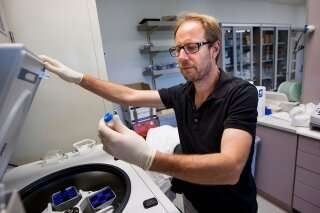
The carnival worker who tries to guess your age relies on aspects of your appearance, such as your posture and whether any wrinkles emanate from the corners of your eyes and lips. If the carny’s guess is more than a few years off, you win a stuffed koala.
But a team of Stanford University School of Medicine scientists doesn’t need to know how you look to guess your age. Instead, it watches a kind of physiological clock: the levels of 373 proteins circulating in your blood. If the clock is off, you don’t win a plush toy. But you may find out important things about your health.
“We’ve known for a long time that measuring certain proteins in the blood can give you information about a person’s health status—lipoproteins for cardiovascular health, for example,” said Tony Wyss-Coray, Ph.D., professor of neurology and neurological sciences, the D. H. Chen Professor II and co-director of the Stanford Alzheimer’s Disease Research Center. “But it hasn’t been appreciated that so many different proteins’ levels—roughly a third of all the ones we looked at—change markedly with advancing age.”
Changes in the levels of numerous proteins that migrate from the body’s tissues into circulating blood not only characterize, but quite possibly cause, the phenomenon of aging, Wyss-Coray said.
A paper describing the research will be published Dec. 5 in Nature Medicine. Wyss-Coray is the senior author. The lead author is neurology instructor Benoit Lehallier, Ph.D.
‘Proteins are the workhorses’
The researchers analyzed plasma—the cell-free, fluid fraction of blood—from 4,263 people ages 18-95. “Proteins are the workhorses of the body’s constituent cells, and when their relative levels undergo substantial changes, it means you’ve changed, too,” Wyss-Coray said. “Looking at thousands of them in plasma gives you a snapshot of what’s going on throughout the body.”
The study’s results suggest that physiological aging does not simply proceed at a perfectly even pace, but rather seems to chart a more herky-jerky trajectory, with three distinct inflection points in the human life cycle. Those three points, occurring on average at ages 34, 60 and 78, stand out as distinct times when the number of different blood-borne proteins that are exhibiting noticeable changes in abundance rises to a crest. This happens because instead of simply increasing or decreasing steadily or staying the same throughout life, the levels of many proteins remain constant for a while and then at one point or another undergo sudden upward or downward shifts. These shifts tend to bunch up at three separate points in a person’s life: young adulthood, late middle age and old age.
The investigators built their clock by looking at composite levels of proteins within groups of people rather than in individuals. But the resulting formula proved able to predict individuals’ ages within a range of three years most of the time. And when it didn’t, there was an interesting upshot: People whose predicted age was substantially lower than their actual one turned out to be remarkably healthy for their age.
The researchers obtained their samples from two large studies. One of them, known as the LonGenity study, has assembled a registry of exceptionally long-lived Ashkenazi Jews. It was able to provide many blood samples from people as old as 95.
On measuring the levels of roughly 3,000 proteins in each individual’s plasma, Wyss-Coray’s team identified 1,379 proteins whose levels varied significantly with participants’ age.
Divergence
A reduced set of 373 of those proteins was sufficient for predicting participants’ ages with great accuracy, the study said. But there were cases of substantial divergence between participants’ chronological and physiological age—for example, among the subjects in the LonGenity study, with their genetic proclivity toward exceptionally good health in what for most of us is advanced old age.
“We had data on hand-grip strength and cognitive function for that group of people,” Wyss-Coray. “Those with stronger hand grips and better measured cognition were estimated by our plasma-protein clock to be younger than they actually were.”
The study also strengthened the case that men and women, who were about equally represented in the study, age differently. Of the proteins the analysis found to change with age, 895—nearly two-thirds—were significantly more predictive for one sex than for the other.
“The differences were striking,” Wyss-Coray said. He added that this finding strongly supports the rationale for the National Institutes of Health’s policy, instituted in 2016, promoting increased inclusion of women in clinical trials and the demarcating of sex as a biological variable.
Any clinical applications of the technique are a good five to 10 years off, he said. With further validation, though, it could be used not only to identify individuals who appear to be aging rapidly—and, therefore, at risk of age-linked conditions such as Alzheimer’s disease or cardiovascular disease—but also to find drugs or other therapeutic interventions, like leafy green vegetables, that slow the aging process, or conversely to flash an early warning of a drug’s unanticipated tendency to accelerate aging.
“Ideally, you’d want to know how virtually anything you took or did affects your physiological age,” Wyss-Coray said.
While the words “373 proteins” may conjure up the image of a transfusion-sized blood extraction, a drop is all it takes for a 373-protein readout.
Source: Read Full Article
